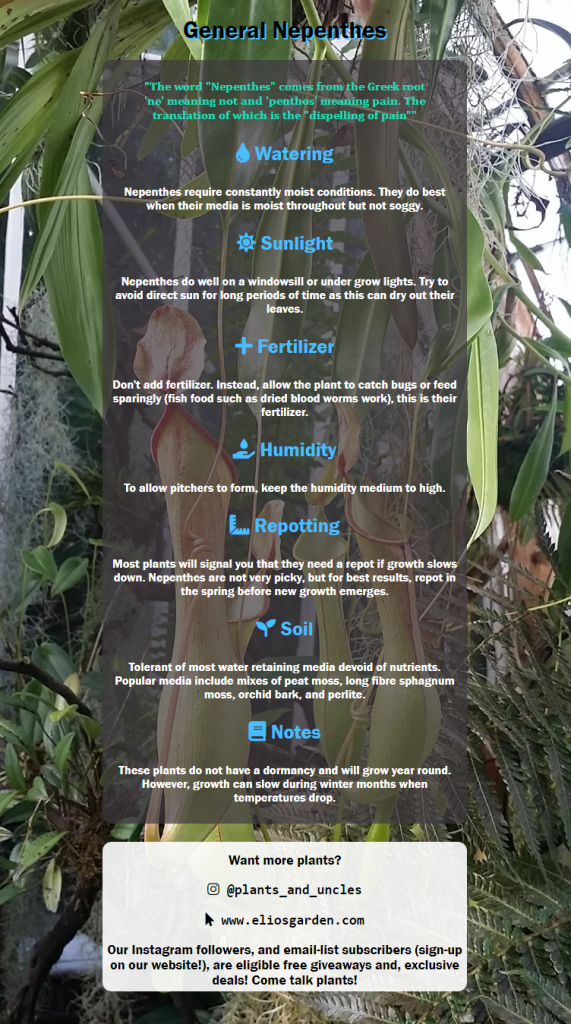Here you can find care instructions we use to grow our many kinds of highland Nepenthes (tropical pitcher plants)!

Nepenthes
Watering
Nepenthes should be always moist but should not be left to sit in water for an extended period. Overhead watering is beneficial and one can even refill the pitchers to about half the volume if needed.
Sunlight
Bright indirect light, to shade is favored for pitcher creation. A windowsill in a kitchen is a great place for this plant!
Fertilizer
Do not add fertilizer. Instead, allow the plant to catch bugs or feed sparingly (fish food such as dried bloodworms work, but a plant outside, and even inside in some cases will catch enough to survive). Food is not required but is beneficial to the plant.
Humidity
Above-average humidity is preferred. A kitchen is ideal due to evaporating water. Using a pebble tray with water filled to the top of the pebbles (so that the plant’s roots do not sit in water but water is evaporated around the plant), can be helpful in raising the humidity.
Repotting
Repot anytime as this plant has no dormancy. However, take caution not to disturb the roots.
Soil
Tolerant of most water retaining media devoid of nutrients. Popular media include peat moss, long fiber sphagnum moss, horticultural sand, orchid bark, and perlite mixes.
Notes
Optionally – When bringing your pitcher plant home, after watering, seal the plant in a ziplock bag in order to keep the humidity up and help retain the pitchers. After a period of 2 weeks or so your plant will begin to acclimatize and you can start to lower the bag around the plant to bring it to the humidity of its new growing space. If pitcher creation ceases, increase light and humidity around the plant. Softer-leaved or indumentum-less nepenthes can be somewhat more pest-prone than other nepenthes. This is just precautionary and is optional as our pitcher plants including our “St. Gaya”, sanguinea, ventrata, ventricosa, and “Rebecca Soper” are acclimatized to roughly home humidity already.
Questions
Why are my pitcher plant’s pitchers dying?
If you pitcher plant’s pitcher are drying up or turning brown you might wonder: Why is my pitcher plant dying? Not to worry, your pitcher plant is not dying if just your pitchers are drying up or turning brown. They could be drying up due to a change in conditions, plant stress, or just cycling off. Pitchers are part of the leaf of these types of plants and will therefore die off as old leaves die off and new leaves grow in. If your plant does not have any pitchers it may be a sign that your conditions are not optimal for your plant. Please consult the above instructions to help make sure your plant grows happily for you!
Why is my pitcher plant not producing pitchers?
We have an article here on helping you get lots of pitchers out of your plant. Mainly, light and humidity are the biggest factors in pitcher production given an otherwise healthy plant. Check out the article for more information!
Hello plant lovers! Please enjoy these general care instructions for Nepenthes. These instructions are basics and have been adapted from multiple sources and our experiences as growers in Burnaby, British Columbia. In fact, we carry a larger variety of Nepenthes than any other genus! We are always learning and adapting these instructions as we discover more methods to grow these incredible plants! We have grown Nepenthes (tropical pitcher plants) for many years on windowsills, and under grow lights, and have had good results using these methods.
Please feel free to contact us with any questions, amendments, or concerns. We would be happy to provide more resources, or chat with you! We will update these instructions periodically and add more resources to reference so please come back soon!
Happy Growing!